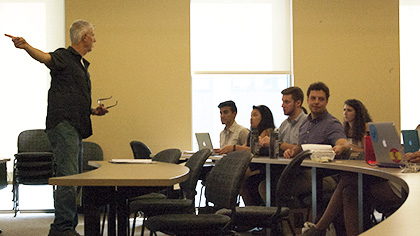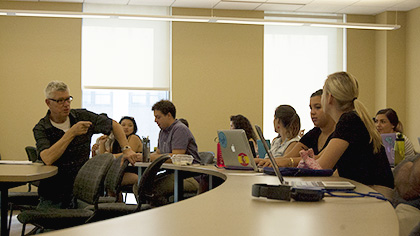New Advertising Creative Program
| September 2, 2015 |
|---|
By Travis Cornejo
Feeling creative? The School of Communication is set to begin a new Creative Advertising program, preparing students to graduate with a completed portfolio of advertising work.
Loyola is set to become one of only five U.S universities to offer such a program, joining the University of Texas at Austin, the University of Colorado Boulder, Syracuse University and the University of Oregon.
Associate Professor Pam Morris worked with the faculty in advertising and public relations and an outside consultant to develop the program. Then the school hired a former advertising creative director with 25 years of experience to anchor the new program. Robert Akers joined the school for the fall, and has worked at BBDO, FCB and Leo Burnett. His portfolio includes work on national advertising campaigns for Nintendo, Disney World, Morgan Stanley and Kellogg’s.
Current freshmen will be able to apply to the program prior to the spring 2017 semester, and the application process is still being refined.

“It's beginning in the sense that this incoming freshman class will be the first class poised to join this program,” Akers said. “However, it won’t be until next year, when we start developing other courses, that they’re really able to say there’s a difference from what the seniors and juniors went through.”
Each semester over the next three years, the School of Communication will offer new classes as part of the program.
“Students will need to take some of the core classes,” Morris said. “They will have to apply to get in, and that will be their sophomore year. They can’t wait any longer, because it is a whole progression. That’s the tricky part.”
There will be a review process, Akers said, to determine who’s really qualified for the program. But because students might not have the necessary skills or experience at the time of application, he said they will try to assess the potential for creative talent and see if the student has the potential for success in advertising.
“We know there’s going to be demand for it, because students have been asking for this,” Morris said. “We’ve expanded the School of Communication and advertising program, but we just don’t have enough for creative types.”
This new advertising creative major will be an alternative to the many “portfolio schools” across the country. Portfolio schools are not degree programs, but more similar to trade schools, where students spend two years working on an advertising portfolio, Akers said.
“Right now, when ad agencies hire copywriters or art directors, they have a very strong bias towards students who come out of these portfolio schools,” Akers said. “Because they’re well prepared, and they can hit the ground running. It’s very difficult right now for students at DePaul, Loyola or any other university, to get a job at an ad agency. They don’t have the skills.”
This new program will address that problem. And it won’t just benefit Loyola students, he said, but high school students as well. Those interested in a future in advertising will be able to attain a liberal arts education and foundation in advertising, without attending a portfolio school.

“I think the diversity in course work is beneficial because it helps foster a more well-rounded character,” said Jake Brusha, a School of Communication graduate who now works at Leo Burnett. “Not that I use any of my math or philosophy education, but the fact that I had to go through with it helps me when I am struggling with a frustrating client or project. I remember and think to myself, ‘It can't be as bad as science courses.’”
A problem with portfolio schools, Morris said, is they can be too focused on the mechanics. In the two years it takes to compile a portfolio, a student isn’t getting the educational foundation to think critically.
“[Portfolio school graduates] can really shine, and their books are fantastic, but will they get through the first year?” Morris said. “Are they going to be able to think critically and ethically? Advertising agencies, unfortunately, have issues with that—with thinking ethically—and it’s going to catch up with them.
Akers said Loyola created a very unique program that presents a very unique opportunity for students. In previous teaching positions, he was frustrated about the lack of preparedness for students looking to enter advertising.
“But my frustrations will now be resolved,” he said. “By taking this job at Loyola and helping develop this program, we’ll be able to give students a liberal arts education along with the skills to land a job in a creative department.”
When creating the curriculum, Morris said she tried to understand what skills students needed for a future in creative advertising, and how to best develop those skills.
“We looked at what students needed, and then we looked at our current curriculum to see what classes could be used toward this major and to see what classes we needed to create,” she said.
This fall, Akers is teaching COMM 214, Introduction to Creative Concepts. In the spring, he’ll teach a brand new course, COMM 266, Creative Thinking and Problem Solving.

“You do have to finish a portfolio in order to get in the business in a creative position,” Morris said. “That’s what we’re trying to develop through this curriculum. A lot of students, they wanted to be in advertising, but we didn’t have enough classes to fulfill that requirement.”
As Morris and Akers flesh out the program, they will also tackle the split between the students more interested in copywriting and the students more interested in design.
“[In the creative field], you’re always going to work in pairs,” Morris said. “You have to start developing those skills right away. There is a balance. Both of them have to have big ideas. That’s what sells. That’s how you’re going to make it in the business.”
